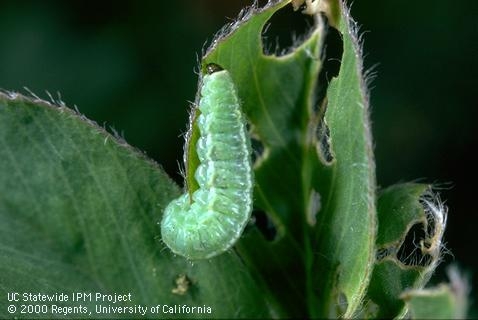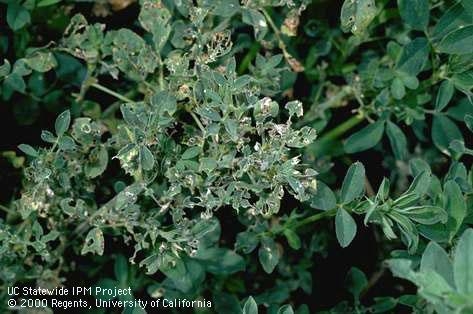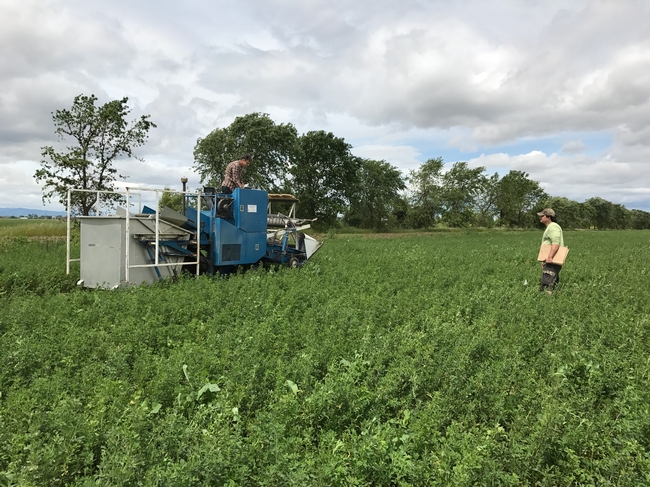It's that time of year again to watch for those evil alfalfa weevils! Weevils are key pests of alfalfa, causing yield and quality losses mainly to the first alfalfa hay cutting. The alfalfa weevil complex includes the Western, Egyptian, and Eastern strains that are all likely the same species (Hypera postica). Each year, growers throughout the country deal with this devastating pest. Telltale signs of weevil damage are small holes in the leaves of the new growth during the winter and spring, depending on field location. Damage is most severe in the first cutting, with large uncontrolled infestations potentially causing damage to the alfalfa regrowth under windrows within the second cutting.
In California we have the Egyptian alfalfa weevil that's found in the low desert and Central Valley where it thrives in hot, dry climates. The Intermountain area has traditionally had more of the western strain that prefers cooler conditions, but with recent warmer winters, the Egyptian alfalfa weevil populations may have a stronger presence there. This may be the reason that we see huge outbreaks of weevils in areas that historically have not been a significant problem. The western strain has also always been under some biocontrol by parasitoid wasps (parasites), but not the Egyptian strain. Alfalfa weevil resistance to pyrethroids in the Intermountain area near Mount Shasta is also causing control problems as discussed in Weevil insecticide resistance.
Management Practices
Management practices for weevil control can be found on the 2017 UC IPM guidelines for alfalfa hay and are summarized below.
Biocontrol: There's some biocontrol of the western alfalfa strain by parasites (parasitoid wasps). However, the Egyptian alfalfa weevil kills parasites that prey on them by encapsulating and killing the eggs that the wasps lay inside them.
Cultural practices: Early cutting reduces yields and weevils can continue feeding under the windrows on the alfalfa re-growth so is not recommended (unless it is used for green chop).
Overseeding with other forage species that weevils don't feed on makes up for the loss of alfalfa production from weevil damage. However, mixed forages will change the quality and the marketability of the hay and therefore is only recommended for older stands in the last years of production to help boost yields, Overseeding older stands.
‘Sheeping off', or close winter grazing, during winter time when the alfalfa is dormant helps reduce weevil numbers and damage to the first cutting when the sheep feed on stems where weevils lay eggs. However, timing is important (alfalfa must be dormant) and watch for excessive soil compaction when it starts raining and overgrazing as discussed in ‘Sheeping off' alfalfa fields adds conservation value.
Monitoring: Alfalfa fields should be monitored to time insecticide treatments for when weevils are feeding on the crop. If sprays are applied too early, a second treatment might be needed which is costly and could lead to more issues with insecticide resistance (see pyrethroids below). Monitor fields with a sweep net using the UC IPM guidelines for alfalfa hay. The current threshold is 20 weevils per sweep. However, far fewer weevils can do a lot of damage depending on the height of the alfalfa, so it is important to watch the fields for injury, especially stubble fields that cannot be sampled with a sweep net.
Insecticide Choices: It's critical to rotate the following different insecticide modes of action (MoA's) for alfalfa weevil control, in order to prevent insecticide resistance from developing:
Organophosphates (OP, chlorpyrifos, Lorsban, Malathion): Chlorpyrifos is becoming more difficult to use due to regulations (Chlorpyrifos ban averted). Imidan, Malathion, and Dimethoate have a shorter residual than other insecticides such as pyrethroids.
Pyrethroids (Warrior, Baythroid): Overall good weevil control, however, alfalfa weevils have been showing pyrethroid insecticide resistance within the Intermountain region, specifically in the Scott Valley area near Mount Shasta.
Indoxacarb (Steward): Good material though a bit more expensive than other insecticides. Needs favorable weather conditions to be effective, gives about 2-weeks residual (pyrethroids offer closer to 3 weeks of control), and does not control aphids. Steward is a stomach poison, so the weevils must ingest it to kill them. Lower rates can be used in warmer areas when the weevils are actively feeding. Higher rates are needed where it is colder and weevils may not be as active. Good results with longer residuals have been obtained by mixing Steward with pyrethroids for weevil and aphid control.
Spinosad (Entrust): Entrust has always been intended for organic production with up to 70% weevil control, but a shorter residual than conventional insecticides. It's the best insecticide we have for controlling weevils in organic alfalfa fields.
Carbamates: Sevin causes significant burning of the alfalfa foliage. Lannate has good weevil knockdown but no residual activity (weevil populations will bounce back).
Alfalfa weevils are increasingly becoming difficult to control. With a grant from the California Department of Pesticide Regulation (2016-19), we are testing new insecticides and re-evaluating the economic threshold levels for weevil control in alfalfa production in California. Stay tuned for results!


